Trying to choose a survival water filter can be tough and confusing.
You need to consider multiple, often conflicting factors such as:
- Type of filter
- What the filter can treat
- Ease of use
- Flow rate
- Cartridge rate
- Durability
- Portability.
Here is what you need to know and the best survival water filters for each situation.
Best Survival Water Filters – Quick Reference
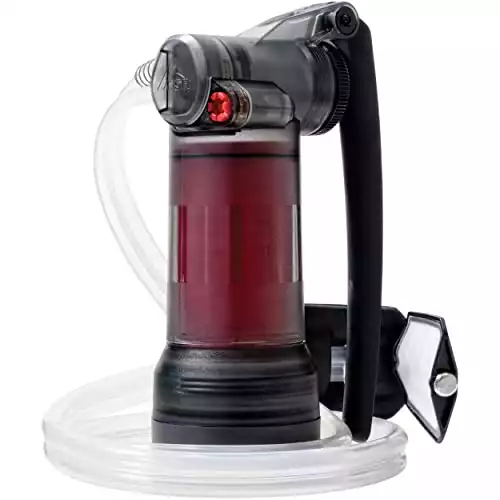 MSR Guardian Water Purifier
MSR Guardian Water Purifier
One of the few filters that can remove viruses while maintaining a fast flow rate. It can also withstand being frozen, work in shallow water sources, and self-clean.
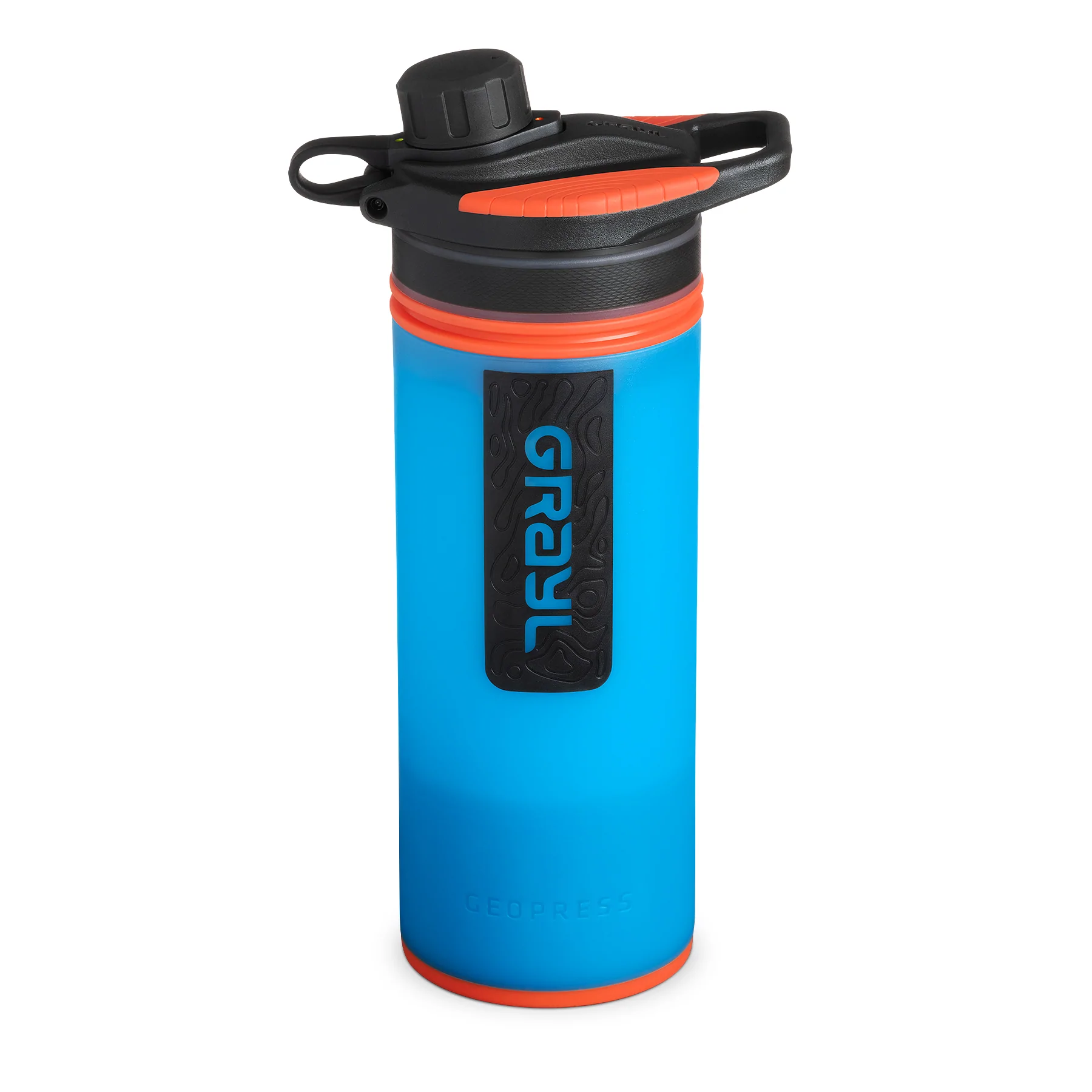 GRAYL GeoPress
GRAYL GeoPress
Small, lightweight, and can remove bacteria, protozoa, viruses, and even chemicals from water. This makes it perfect for bugging out virtually anywhere.
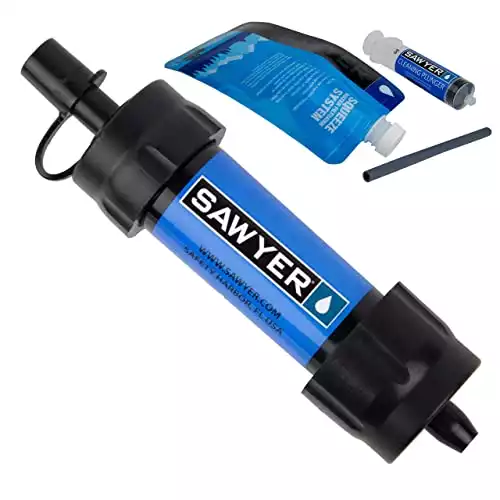 Sawyer Products MINI Water Filtration System
Sawyer Products MINI Water Filtration System
Easy to use, super lightweight, reliably removes bacteria and protozoa from water, and is incredibly cheap.
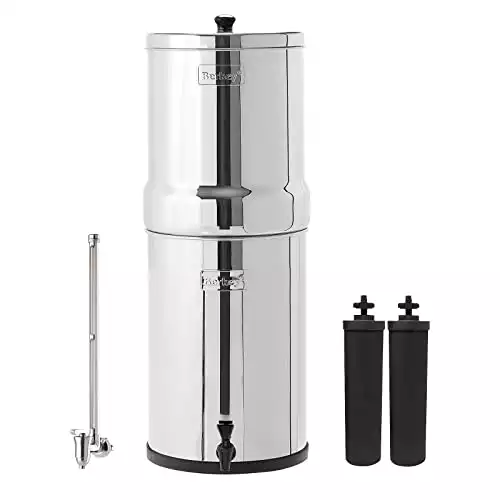 Big Berkey Gravity-Fed Water Filter System
Big Berkey Gravity-Fed Water Filter System
Berkey black filters remove a wide range of contaminants from water, and they do it easily. The cost is high, but it’s worth it if you need to hunker down at home through a disaster.
Survival Water Filter Reviews
There are dozens of excellent survival water filters out there. We narrowed them down to these top picks based on their ability to filter multiple types of contaminants, the cartridge life, and how practical they are to use in survival situations.
MSR Guardian Pump Filter
Type: Pump | Filter: 0.02 micron | Flow rate: 2.5 liters per minute
Weight: 17.3oz | Cartridge Life: 10,000+ liter | Clean: Self-cleaning
Removes: Bacteria Viruses
Chemicals
The MSR Guardian Purifier has long been considered the best survival water filter. It may seem like a simple pump filter, but it has some standout features that set it above the competition.
The MSR Guardian Purifier features a hollow fiber filter with a micron rating of 0.02. That’s small enough to filter out viruses, bacteria, and protozoa.
The cartridges can last for over 10,000 liters. Replacement cartridges are available on Amazon.
Another standout feature of the MSR Guardian filter is that it can be frozen. Other filters get ruined in freezing weather. The filter also is durable as heck and can be dropped from 6 feet and not break.
Pumping is undoubtedly easier than squeezing, which makes the Guardian much easier to use. It’s also faster. The flow rate of 2.5 liters per minute is 5x faster than the Sawyer Mini and 2.5x faster than the Sawyer Point Zero Two (which also removes viruses).
A cool thing about the MSR Guardian is that it is self-cleaning. When you pump the filter, 10% of the water is used for flushing sediment out of the filter. That means you never have to backwash or scrub the filter clean.
The main downside of the MSR Guardian Purifier is its high price tag. Even the replacement cartridges are expensive. It’s also cumbersome at 17.3oz. Note that it doesn’t remove chemicals, so you’d need to carry activated carbon if you suspected chemicals in the water.
Pros
Filters viruses
Long-lasting cartridge
Self-cleaning system – no need to backflush
Very durable
Fast flow rate
Withstands freezing conditions
Cons
A bit heavy and bulky
Pricey
Best For: Quickly treating water from various sources, especially while on the go.
GRAYL Geopress Water Purifier
Type: Bottle | Filter: Electroabsorption | Flow rate: 5 liters per minute
Weight: 15.9oz | Cartridge Life: 65 Gallons | Clean: Manual
Removes: Bacteria Viruses
Chemicals
GRAYL is a newer water filter company that has quickly built up a following of enthusiasts. The main reason people love it is that the GRAYL is so easy to use.
You put dirty water into the bottle. Then you just push the filter tube into the bottle. Screw it in place, and you can immediately drink the water from the bottle. Or empty the clean water into another container and filter some more water.
It only takes 8 seconds to filter 24oz, which breaks down to 5 liters per minute. It’s definitely easier than squeezing!
GRAYL doesn’t use membrane filter technology to treat water. Instead, it uses electroabsorption. The filter element works on ion exchange, powdered activated carbon, and silver-treated zeolites.
Because of this technology, the GRAYL bottle can remove:
- Bacteria and protozoa
- Viruses
- Many chemicals (pesticides, chlorine, benzene, chloroform)
- Many heavy metals
- Microplastics
- Bad tastes and odors
The only downside of the GRAYL purifier bottle is that its cartridge lifespan is only 350 presses (or about 65 gallons). You’ll know that the bottle is reaching the end of its lifespan when the press time reaches 25 seconds.
The short lifespan wouldn’t be such a big issue if the GRAYL weren’t expensive. You end up paying about $1.38 per gallon of treated water. At that price, you are better off stockpiling lots of bottled water at home!
But, for use on questionable water – such as bugging out through a flooded city – the GRAYL would be well worth the cost.
Pros
Compact and lightweight
Removes all types of contaminants
No squeezing
Works quickly
Cons
Short cartridge life
A bit pricey
Recommended For: Urban bug out bags, flood preparedness
Sawyer Mini
Type: Squeeze | Filter: 0.1 micron | Flow rate: 0.5-1 liters per minute
Weight: 2oz | Cartridge Life: 100,000 gallons | Clean: Backflush
Removes: Bacteria Viruses
Chemicals
I have long been an advocate of the Sawyer Mini water filter. It is by far one of the most straightforward survival water filters to use.
Just fill the included pouch with dirty water, screw on the Sawyer Mini filter, then squeeze to get clean drinking water.
It’s pretty versatile too. You can buy adapters to use as an in-line filter. With that adapter, you can rig up a gravity filter. The filter comes with a straw attachment.
The plastic pouches it comes with aren’t great and will pop quickly, but you can screw the filter onto a regular plastic bottle instead.
I mainly love the Sawyer Mini because it has a 100,000-gallon cartridge life. In other words, it can be used forever. If it starts to get clogged, just backflush it.
There’s no need to ever buy replacement cartridges or worry about whether your filters have reached the end of their life (Note that I did have to replace the O ring on my Sawyer Mini after about 5 years of use).
Considering how cheap the Sawyer Mini is and that you’ll never have to buy a replacement cartridge, it’s the most affordable survival water filter you could get.
The downside of the Sawyer Mini is that it only treats bacteria and protozoa. This is fine for backcountry use, like when backpacking or camping.
However, the Sawyer Mini will be ineffective for treating sketchier water, such as floodwater or water near farms (due to agricultural runoff).
In these cases, you’d need to take extra steps, such as boiling the water to kill viruses or using activated carbon to remove chemicals.
Like other hollow-membrane water filters, the Sawyer Mini cannot be used after being frozen. That’s because the frozen water inside the filter will expand and burst the filter membrane.
Pros
Very small and lightweight
Versatile
1 million gallon life
Very affordable
Cons
Will be destroyed in freezing weather
Included pouches pop quickly; will need backups or to screw it onto a plastic bottle
Recommended For: Prepping on a budget; bug out bags away from urban areas.
Big Berkey with Black Filters
Type: Tabletop | Filter: Mixed media | Flow rate: 1.75 liters per minute
Weight: 9lbs | Cartridge Life: 6,000 gallons| Clean: Manual
Removes: Bacteria Viruses
Chemicals *reduces
Berkey is one of the only tabletop water filters which could be used in an emergency or complete SHTF situation. Not only do their “Black” filters remove bacteria and protozoa, but they also remove viruses and reduce chemicals and heavy metals.
In independent tests of water filters, the Berkey consistently performs well. In other words, it does what it claims to do.
However, it should be noted that the Berkey filters are not independently certified to NSF/ANSI standards. Because of this, the Berkey systems are unavailable in California or Iowa. Read about Berkey alternatives.
The Berkey filter unit comes in various sizes. There is a travel size that could be used for camping trips. The Big Berkey (2.1 gallons) is a good choice for up to 4 people at home. The Big Berkey holds up to 4 “Black” filters. You can also get optional fluoride filters.
There is a lot of confusion about how Berkey Black filters work. They only give a vague description on their website. Based on this, we can assume that the filter contains a hollow-fiber filter for bacteria (no micron rating provided) and activated carbon or similar technology for absorbing chemicals and bad tastes.
The company claims a pair of Black filters can last up to 6,000 gallons. I’m assuming that part of their filter contains activated carbon, though. Since activated carbon absorbs contaminants, its lifespan is shorter with dirty water.
If you were to filter very contaminated water, we can assume that you’d need to change the filters much sooner than the 6,000-gallon claim. Most activated carbon filters need changing after 150 gallons or less!
The bottom line? I would be fine going by the 6,000-gallon cartridge life when using with tap water under normal circumstances. If you want to use a Berkey to remove chemicals in a SHTF situation, you should be prepared to change the filters more frequently.
Pros
Attractive tabletop system
Easy to use
Removes or reduces virtually all types of contaminants
Stainless steel
Cons
Filter life is likely much less than advertised
Expensive system and replacement filters
Not independently certified to NSF/ANSI standards
Not available in California or Iowa
Best For: Everyday use as well as emergency preparedness.
Platypus 4L GravityWorks Filter System
Type: Gravity | Filter: 0.2 micron | Flow rate: 1.75 liters per minute
Weight: 11.5oz | Cartridge Life: 1500 liters | Clean: Backflush by reversing
Removes: Bacteria Viruses
Chemicals
When it comes to gravity water filter systems, the Platypus GravityWorks filter is consistently voted the best.
The top reservoir holds 4 liters of dirty water, and the bottom reservoir holds 4 liters of clean water, giving it a total capacity of 8 liters. There are also smaller versions available too.
The system is designed to filter a lot of water quickly. While not nearly as fast as the MSR Guardian, you don’t have to do any pumping for the GravityWorks.
The kit has a 0.2-micron hollow fiber filter. It will remove bacteria and protozoa, but it will not remove viruses or chemicals. However, a carbon filter element can be used with the kit (sold separately).
Like with similar filters, it can be backflushed. You just reverse the gravity bags, and the filter will be cleaned out.
Pros
Easy to use
Filters and holds a lot of water at once
Compact
Cons
No shower attachment
Not versatile
Best For: Filtering a lot of water at once in a backcountry camp
Renovo Water MUV Eclipse Water Filter System
Type: Multi-functional | Filter: 0.1 micron/carbon/nano | Flow rate: 1 liter per minute
Weight: 14.5oz | Life: 150 (MUV1); 100,000 (MUV2); 90 (MUV3) gallons | Clean: Backflush
Removes: Bacteria Viruses
Chemicals
The MUV Eclipse is one of the newer water filters to hit the market.
Compared to other options, MUV is by far the most versatile survival filter you can get.
It is made up of three different filters in one. You can snap the different parts of the filter together to use them all at once. Or just use the filter parts that you need.
Here are the 3 parts of the filter:
MUV1: Activated Carbon Fiber (150-gallon life)
The activated carbon in this part of the filter removes chemicals, chlorine, and heavy metals. It will also remove bad tastes and odors from water.
MUV2: Hollow Fiber Filter (100,000-gallon life)
This is a 0.1-micron filter for removing protozoa and bacteria. It can be considered the main component and is what you’d want to use in the backcountry, where the water is free of chemicals and viruses.
MUV3: Nanalum Virus Filter (90 gallon life)
If you suspect viral contamination in the water, you’ll also want to use this part of the filter. It uses nanalum technology which gets a positive charge when wet. The charge acts like a magnet to capture and trap organic contaminants. There is also Granular Activated Carbon in the filter layer to absorb impurities.
What’s cool is that you can mix and match the parts to filter what you need. Going into the backcountry where chemicals and viruses aren’t an issue? Just use MUV2. Need to treat flood water? Connect all three components!
The other cool thing is that the filter component can be used differently. You can use it as a straw to drink right from the source. It can go inside a water bottle. Or use the in-line adapter. Or use it as a gravity filter. Best of all, attach it to the PUMP and collect water in a separate vessel (no squeezing!!!).
There’s even a bucket adapter included. You get the point. It’s damn versatile.
Some people also might be annoyed by all the parts that come with the MUV Eclipse kit. I can see how it would be annoying to keep track of them and that you could lose one. I don’t find this a problem, though, because you can just use the parts you need. All those parts are what make it so versatile.
Compared to other water filters, which do the same thing (well, no system does all of this…), the MUV Eclipse kit is very affordable. There are replacement filters available for the MUV1 and MUV3.
The MUV Eclipse is undoubtedly an interesting product; however, the company is still very new, and there isn’t much info available on their test results.
For these reasons, it’s probably better to play it safe and go with a reputable brand like MSR.
Pros
Three filters in one
Can mix and match filters based on need
Works as pump, straw, gravity, and bottle filter
Very versatile system
Affordable
Good cartridge life
Replacement carbon and virus filter parts are affordable
Cons
Flow rate not given
New company; needs further testing
Lots of parts that you could lose
Best For: If you want just one filter that can do everything.
Filters vs. Purifiers
A lot of people use the terms water filter and water purifier interchangeably. While they are both water treatment systems, filters and purifiers differ.
Water Filters
Water filters are like sieves with tiny holes rated in micrometers (microns for short). The holes trap contaminants so only clean water can pass through.
Most water filters have holes that are around 0.1 or 0.2 microns in size. This is small enough to keep out bacteria and protozoa. However, most water filters will NOT remove viruses. Thus, most water filters can’t be considered purifiers.
Water Purifiers
A purifier is a water treatment system that can also treat viruses, bacteria and protozoa. One example of a water purifier is SteriPen (Amazon link). It works by blasting the water with UV light. Water treatment tablets are another popular type of water purifier.
These systems are highly effective. However, they don’t remove sediment from water. For example, you could collect a cup of water from a swamp and safely drink it, but the mud (and bits of dead bugs, etc.) would still be in the water.
As mentioned before, water filter technology has improved drastically over the past few years. There are now several water filters that have filter hole sizes small enough to remove viruses. Thus, these filters can be called “purifiers.”
Water Filter Micron Rating Explained
For a water filter to work, it must catch harmful contaminants while still allowing water molecules to pass through. The size of the holes or pores that catch contaminants are measured in microns.
Below you can see the micron size of various contaminants compared to water.
Micron Sizes
- Water Molecule: 000282 microns
- Width of Human Hair: 75 microns
- Mold: 3-12 microns
- Protozoa/Cysts: 4-5 microns
- Bacteria: 1-10 microns in length and 0.2 to 1 micron in width
- Lead Dust: 1-0.7 microns
- Viruses: 004-0.3 microns
- Pesticides: 001 microns
(Source: 1)
A good water filter will have a micron rating of at most 0.2 microns. If it were any larger than this, bacteria would be allowed through.
For a water filter to remove viruses, the micron rating must be less than 0.1. Bear in mind that this is a very tiny hole size! Thus, water filters which remove viruses will be very slow and get clogged easily.
Absolute vs. Nominal Micron Rating
Some water filters list their nominal micron rating. This is an average of the pore sizes. Some pores could be larger than listed and thus let bacteria through.
By contrast, better water filters list their absolute micron rating. This is a measurement of the maximum pore size in the filter. A 0.2 absolute micron rating won’t let anything 0.2 microns or larger through (meaning no bacteria pass).
What Do Water Filters Treat?
Before choosing a survival water filter, you must consider what types of contaminants might be in the water you want to treat. Not all water filters remove the same contaminants.
Here’s a breakdown of the types of contaminants found in water during emergencies and what kind of filter is needed to treat them.
Protozoa
Protozoa are single-cell organisms. The dormant form of protozoa are called cysts. The most notorious ones found in water are Cryptosporidium and Giardia.
Protozoa are very common in water (even “clean” backcountry water) and are responsible for giving many a backpacker terrible diarrhea.
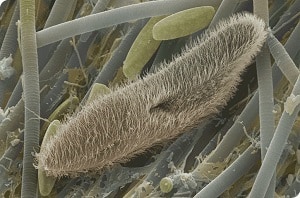
The good news is that protozoa and their cysts are relatively large. Most are around 2 to 50 microns in size. Giardia cysts, for example, are around 7-10 microns. These are easily removed by water filters with a micron rating of 0.2.
Bacteria
Bacteria are also single-cell organisms but can be much smaller than protozoa cysts. They are usually about 1-10 microns long and 0.2 to 1 micron in width. Thus, you need a water filter with a 0.2-micron rating or less to remove bacteria.
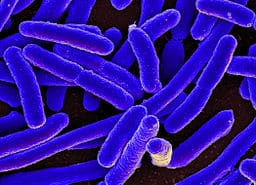
Like protozoa, bacteria can even be found in backcountry water which appears clean. When I go backpacking, I take my Sawyer Mini to treat water from springs, lakes, etc., so it is safe to drink.
Viruses
Viruses are tiny. Most viruses are 0.01 – 0.3 microns in size. However, some viruses are as small as 0.004 microns. This makes viruses very difficult to filter. Even water filters that say they remove viruses won’t remove every single type of virus.
Rotavirus is 0.070 microns. Hepatitis A and E are 0.027 microns. Norwalk virus is 0.027 microns. (Source)
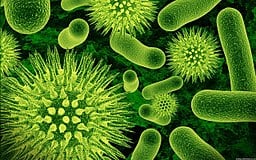
The good news is that viruses usually aren’t a problem in backcountry water. Only cholera and polio can survive and reproduce in water (at least for now, with the rise of superbugs), and even then, the UV light from the sun usually can kill bacteria. Hence why I can use my Sawyer Mini water filter when backpacking.
However, in disaster situations like flooding, viruses from sewage contamination can become a huge risk. Thus, a water filter like the Sawyer Mini won’t treat flood water adequately.
You need to worry about viruses in water:
- In urban areas where there is sewage contamination in the water source
- After severe flooding (again because of possible sewage contamination)
- In undeveloped countries where water may be contaminated by poor sanitation
- In very popular backcountry areas where irresponsible campers go to the bathroom too close to a water source
Note:
If your water filter doesn’t remove viruses, you will need to further treat the water by boiling the water for 1 minute. One more reason to have a survival stove in with your survival supplies!
Alternatively, you can treat water with bleach to kill viruses or use a water purification system.
Chemicals
Natural disasters – especially floods – can cause huge amounts of chemicals to contaminate water sources. For example, more than 40 sites released hazardous pollutants after Hurricane Harvey.
Most water filters can remove heavy metals like lead and iron because these particulates are so big. However, chemical pollutants like benzene and pesticides are very tiny.
Benzene, for example, is only slightly larger than a water molecule. Thus, no water filter will be able to filter out benzene.
Only activated charcoal (Amazon) can absorb these chemicals to reduce them.
Many survival water filters (such as the Survival Filter Pro) now have carbon pre-filters that allow you to remove chemicals.
Just note that activated carbon gets filled up quickly (it can’t be cleaned with backflushing like a membrane filter). You’ll have to change the carbon filter often for it to remain effective. (Sources: 3, 4)
Recommended Reading – How to store water
Types of Water Filters
There are a lot of different types of survival water filters out there. Some are better for things like Bug Out Bags, whereas others are better for hunkering down.
Here’s what you need to know about types.
Home Water Filters
The water filter you may have in your home for treating tap water – such as a Brita filter – is NOT made to remove bacteria or protozoa.
These home water filters typically use activated carbon (from coconut shells). The carbon ABSORBS chemicals and heavy metals such as chlorine, lead, and mercury to reduce the amount in the water.
This is different than the survival water filter membranes, which completely BLOCK bacteria, etc., from passing through.
The activated carbon in-home water filters will also absorb some bacteria and protozoa. However, it does not absorb everything. It only reduces the amount.
It only takes a small number of bacteria or protozoa to make you sick. Thus, home water filters (while better than nothing) are not suitable for emergency preparedness.
Note that there are some exceptions to this, though.
For example, Berkey water filters (Amazon link) are made for home use but can remove bacteria, protozoa, and parasites. You could use a Berkey filter to filter pool water and make it safe for drinking in an emergency.
Straw Water Filters
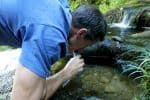
Straw survival water filters gained popularity with the LifeStraw. It allows you to drink water directly from the source.
Personally, I DO NOT like straw filters because they don’t give you a way to collect water.
For example, let’s say I’m in the backcountry and need a way to mix powdered electrolytes (an essential for your BOB first aid kit) with water. There’s no way to do this with a straw filter. Instead, I’d have to gulp the electrolytes and chase them with a drink from the straw.
I’d much rather have a filter system to filter into my water bottle so I have clean water with me.
The only way to make straw-style survival filters work on the move is to put dirty water into your water bottle and use the straw to drink from it. But then you’ve got a contaminated water bottle, which could cause other issues.
This said many people swear by straw water filters for survival situations, such as the Aquamira Frontier Pro (Amazon link), the Lifestraw personal (Amazon link), and other Lifestraw family filters.
Read more about the best water filter straw for survival.
Pros
Easy to use
Small
Affordable
Cons
Can’t bring filtered water with you
Have to crouch down at water source
Squeeze Filters
Ever since Sawyer came out with the Mini (Amazon link), squeeze filters have become a popular choice for the best survival water filter.
They work by putting water in a collection vessel (such as a pouch or a water bottle). Then you screw the filter mechanism onto the vessel. You then physically squeeze the bag, forcing the water through the filter so clean water comes out on the other side.
Because there is no need for a pump mechanism, squeeze water filters are incredibly tiny and lightweight. They are also straightforward to use and can be adapted. For example, you can fit them with straws to drink directly from the water source or attach them to a water bladder to make a gravity system.
Pros
Very small and lightweight
Easy to use
Affordable
Can be cleaned with backflushing
Often can be adapted to use as a straw, in-line filter, or as a gravity system
Cons
Have low flow rates
Not very efficient for multiple people
Bottle Water Filters
There are some bottle water filters where you insert a squeeze or straw-type filter into a bottle. Then you suck or squeeze to get clean water. I would put these in the straw and squeeze category types, though.
By “Bottle water filter,” I’m talking about filters like the GRAYL. They work a bit like a French press coffee maker.
You put dirty water into the bottle. Then you push the filter into the bottle. All the contaminants are pushed to the bottom, and the top portion of the bottle is full of clean water. You can drink right from the bottle or pour the clean water into another container.
Pros
No squeezing required
Easy to use
Lightweight and small
Cons
Difficult to collect water from shallow sources
Not many options
Can only treat a limited amount of water at once
Pump Water Filters
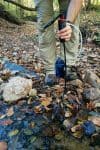
I grew up using this type of water filter on backpacking trips with my dad as a kid. Here’s how they work:
You put one end in the water source. A hand-operated pump pulls the water up and through a filter cartridge. Clean water comes out another end.
Pros
Can get water from shallow sources
Come in different sizes
Treat water fairly quickly
Filters water directly from source – no need for collection vessel
Many options, including ones that treat viruses
Cons
Can be a bit bulky for individual use
Gravity Filters
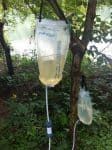
Gravity filters have become more popular recently, especially for family camping.
To use one, you put water inside a pouch and then hang the bag high up (like on a tree). Gravity forces the water down through the filter mechanism, and clean water comes out on the lower side.
Pros
No pumping or squeezing required
Good for filtering a lot of water at once
Cons
Not suitable for shallow water sources
Can take a long time to filter water
Must have an elevated place to hang the reservoir
Pouches prone to breaking when dropped
Also see Big Berkey vs Alexpure Pro comparison.
Water Filter Features
Here are some features we looked at when choosing our top survival water filters.
Filter Material/Technology
There are three main types of materials used to remove contaminants from water. No one material can remove all impurities, which is why many of these materials are often used together.
Here are the primary filter materials used in survival water filters.
Membranes
These can be described as sieves with very tiny holes (rated in microns). The membrane is usually made of hollow fiber but can be made of various other materials.
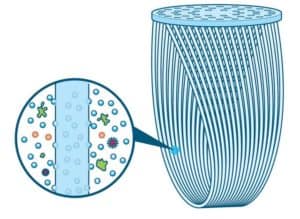
Membranes can be cleaned and/or backflushed, which means they have a very long life. Some membrane filters, like the Sawyer Mini, can last forever.
Important: You can’t let most membrane filters freeze, though, or the frozen water will create large holes in the membrane and ruin them. Thus, these filters are not suitable for cold weather survival.
Activated Carbon
Unlike membranes that block contaminants from passing through, the activated carbon absorbs pollutants.
Most carbon-based water filters have very short lifespans, around 60-90 gallons. The carbon will get filled up faster when the water is very contaminated. Thus, it is hard to determine the actual lifespan of a carbon filter.
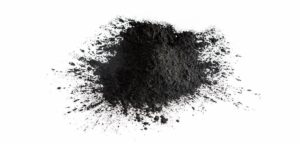
The activated carbon filter mustn’t get used longer than recommended. Once it is “filled,” the filter won’t be able to absorb any more contaminants. It might even leach out the contaminants it absorbed – thus doing more harm than good!
Nano Filters
This is a new technology starting to be found in some filters. It utilizes carbon nanotubes to capture tiny contaminants such as viruses and chemicals.
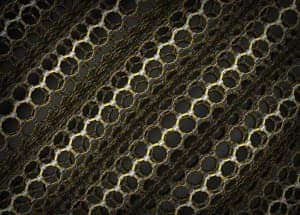
You can read more about the science here.
Cartridge/Filter Life
This indicates how much water the filter can treat before you need to replace it or replace the filter cartridge. Some water filters (like the Sawyer Mini) can last forever. Other filters (such as activated carbon cartridges) must be replaced quickly, such as after 65 liters of water.
Note that water filters with carbon cartridges (for removing chemicals and bad tastes) have very short lives. You will have to change this filter more frequently than a membrane filter.
Micron Rating
You’ll need a micron rating of at most 0.2 to remove bacteria. If you want to remove most viruses, you’ll need a micron rating of 0.01. Just be warned that smaller micron ratings mean slower flow rates.
Flow Rate
Flow rate, usually measured in liters per minute, is how quickly a water filter can treat water. Bear in mind that flow rate is listed under optimal conditions. When the water is murky, it will go much slower. Likewise, water filters will tend to slow down as they get clogged.
Speaking from personal experience, I can tell you that it is incredibly annoying to squeeze for 15 minutes just to get 1 liter of water!
Cleaning Method/Backflush:
Many filters (especially the squeeze kind) can be cleaned with backflushing. This means you shoot clean water through the opposite side to dislodge sediment clogging the filter.
The MSR Guardian Purifier probably has the most advanced cleaning method of any survival water filter: it can clean itself as it pumps!
Durability
If you plan to get something for your Bug Out Bag or backpacking, you want a durable one. Avoid cheap plastic casing.
Weight and Size
For at-home use, a bulky water filter is okay. But you will want something lightweight and compact for your Bug Out Bag.
Activated Carbon Filter Layer
Remember that water filter membranes cannot remove chemical pollutants. The only way to remove these is with an active carbon filter. Many survival filters will add an activated carbon filtration layer.
Just note that the carbon filter usually has a short lifespan, around 60-150 gallons.
Cost
The cost can vary drastically. Cost isn’t always an indicator of quality. For example, the Sawyer Mini is incredibly cheap and still an effective filter for backcountry use. The MSR Guardian is pricey but has advanced features that make it better for multiple people.
Be sure to factor in the cost of replacement filters when choosing. Often the replacement cartridges are nearly as expensive as the filter itself.
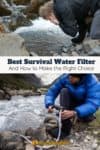
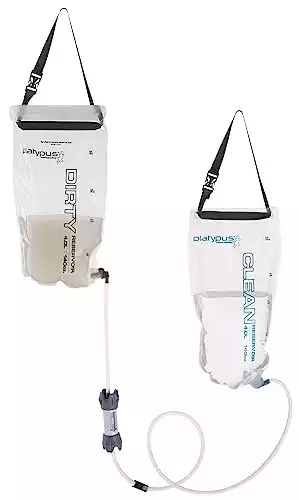
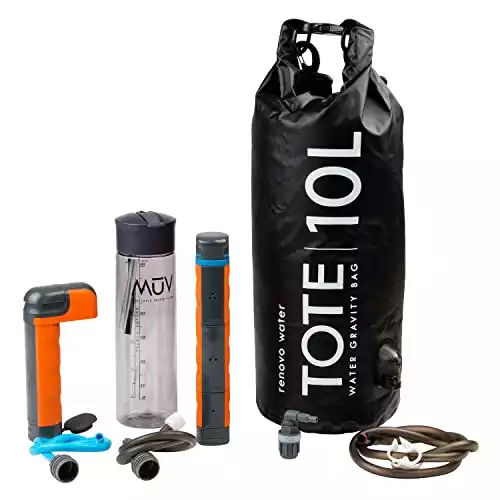




Hello,
Great website, with much useful information!
My plan is to go cycling and wildlife/birdwatching through everywhere in South-East Asia for more than a year, in Indo-China, Phillipines, Indonesia, etc. The dream is to end up in Papua New-Guinea.
While cycling in hot weather I drink about 10 liters of water a day. I don’t want to, and in many remote places I wouldn’t even be able to, buy water bottles for all of that. In Europe (and Georgia, Caucasus, where I’m now traveling) I can use my loyal Sawyer Squeeze filter and filter unlimited amounts of water everywhere, both through a big gravity system or squeezing by hand.
But unfortuntely, the Sawyer Squeeze doesn’t filter viruses out of the water, so it’s only a partial solution for South-East Asia. I don’t know whether it’s possible to buy chlorine dioxide pills/ liquid in many places in South-East Asia and I don’t want to lug around too much. I also don’t like the chemical taste and don’t know whether it’s healthy to use in large quantities for extended periods of time. I could buy a Steripen, but you can treat only one liter of water at a time, you would have to filter the water anyway, and you need to bring multiple spare batteries and possibly another light bulb.
My main options for now are the pumps Survivor Filter Pro X and MSR Guardian, or electrified chemical purifiers Aqua Research H2gO Prime and the Potable Aqua Pure.
The Survivor Filter Pro X seems awesome. It produces very clean (0.01 main filter) and tasty (carbon filter) water without effort (electronic). The downsides are that it is fairly bulky and heavy and, I’ll need one or two carbon filters and, most importantly, that it’s an electronic device and I’m a bit hesistant in placing all my trust for clean water for a year into that. A good option would be to order the manual convertion kit with it. So that, if something happens, you can still manually pump. But it will add even more to the weight and bulkiness of the set-up and the flow rate for manually pumping is really low (0.5 l per minute), which means 20 minutes of pumping for ten liters. So, I wouldn’t want to do that for extended periods.
An alternative would be the MSR Guardian, which is a fully manual pump with an exceptional flow rate of 2.5 l per minute. The downsides are that is is even bulkier and heavier than the Survivor Pro X (without the manual back-up kit), that is has only a 0.02 main filter (compared to 0.01 for the Survivor) and that it is super expensive (almost 400 dollars). It also does not have a carbon filter, so the water will taste less good. Furthermore, there are reports of the pump breaking, which could be a potential disaster and unexceptional for a pump with a price like that.
In either case, I might still bring my Sawyer squeeze filter, combined with chemical drops, as a back-up system.
On the other side are the chemical purifiers Aqua Research H2gO Prime and the Potable Aqua Pure. I couldn’t really find a difference between those two. The upsides are that they are lightweight, you only need salt and that it is easy to pair them with my existing Sawyer Squeeze filtration system. The downsides are that it is chemical, so it makes the water taste less good (although better than usual pills). And from a health perspective I also don’t want to drink a lot of chemically-treated water for a year straight.
I’m still researching and hesitating a lot. I’ll have to make a decision soon, since I’ll be leaving Georgia, Caucasus, in a month and will travel to Thailand afterwards. So, there’s only one more month to let a device ship (from potentially the US) to Tbilisi.
Thanks for any help/suggestions!
Michaël
I’d love to know what you chose. Hope you have had safe and great travels.
In the year 2021 we still can’t do nothing right. I’ll rig up something myself using a brita filter and battery operated UV light.
Amazing.
Same goes for 2 way radios. Those are useless also. I’ll build my own portable base station that transmits far.
“The only way to make straw-style survival filters work is to put dirty water into your water bottle and use the straw to drink from them on the go. But then you’ve got a contaminated water bottle, which could cause other issues.”
Incorrect. You don’t have to put the water in your bottle, you can drink straight from the source.
Drinking from the source is mentioned earlier in the paragraph. That said, the wording could be clearer – I have amended that. Thanks for the heads up.